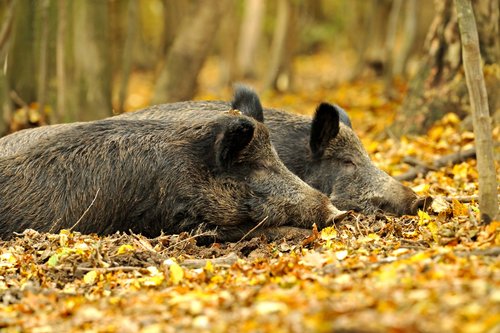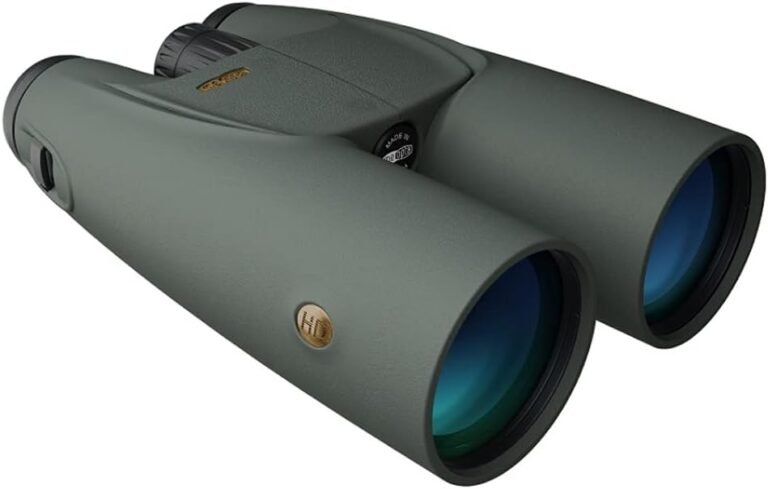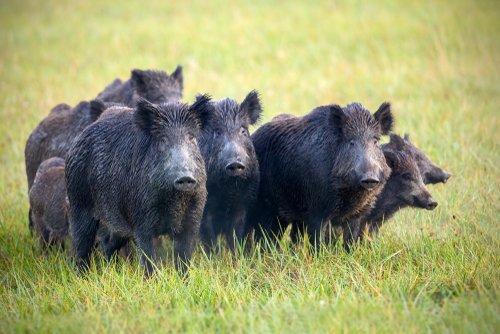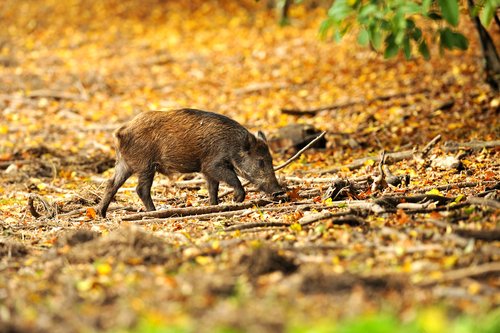Getting Close to the Game: Expert Hog Stalking Tips
Stalking hogs is not for the faint of heart. It requires skill, patience, and a deep understanding of hog behavior. But fear not, my fellow hunting enthusiasts!
This article will delve into the art of stalking hogs and explore strategies that can lead to success in the Wild. To begin with, let’s talk about getting close to wild hogs.
These magnificent creatures have an acute sense of smell and hearing that rivals any hunter’s instincts. To outsmart them, you must become one with the terrain.
Choose your camouflage wisely, blending in with the surroundings to remain undetected. Move slowly and deliberately, carefully placing each footstep to avoid twigs that might snap or leaves that rustle under your weight.
Stealth in hog hunting is paramount. Avoid wearing anything that could produce noise or shine brightly in the sunlight.
Choose clothing from quiet fabrics and muted colors such as earth tones or camo patterns. Remember to minimize movement as much as possible; sudden gestures can alert even the most oblivious hog to your presence.
But what if you encounter obstacles while stalking hogs? Fear not!
Adaptability is key in these situations. Learn how to navigate through thick brush silently by parting branches gently or stepping over fallen logs without making a sound.
Utilize natural cover like tree trunks or large rocks to conceal your approach while keeping a keen eye on their movements. Mastering the art of stalking hogs requires dedication and practice.
By getting close to wild hogs through stealth techniques and understanding their behavior patterns, hunters can increase their chances of a successful encounter in the Wild. So grab your gear, hone your skills, and prepare for an exhilarating adventure!
Stealth in Hog Hunting: The Key to Getting Close to Wild Hogs
Stealth in hunting is crucial when it comes to getting close to wild hogs. These intelligent and wary creatures have an acute sense of smell and hearing, making it challenging for hunters to approach them undetected. However, with the right techniques and a keen understanding of their behavior, you can increase your chances of a successful stalk.
One important aspect of stealth in hog hunting is being mindful of wind direction. Hogs have an incredible sense of smell, allowing them to detect even the faintest hint of human presence.
To avoid being detected by their keen noses, it is essential to always approach hogs from downwind. This means aligning your position so the wind blows from the hogs towards you.
Doing so can minimize the chances of your scent reaching their sensitive noses. Another key element in achieving stealth during hog stalking is controlling movement and noise level.
Hogs are sensitive to smells and highly attuned to unusual sounds or sudden movements around them. Walking slowly and carefully, ensuring each step is deliberate and quiet, will help you blend into your surroundings without alerting the hogs.
Additionally, avoid wearing clothing that rustles excessively or makes noise as you move – opt for materials designed to minimize sound. Furthermore, mastering camouflage techniques can greatly enhance your stealthy approach towards wild hogs.
Choose camouflage patterns that match the natural environment where you plan hunting – this will help break up your silhouette and make it harder for the hogs to spot you at a distance. Use natural materials like twigs or leaves strategically attached to your clothing or gear for concealment.
Remember, blending seamlessly into the surroundings will give you an edge when getting within shooting range without spooking these elusive animals. Achieving stealth in hog hunting is vital in getting close enough to these intelligent creatures for a successful hunt.
By paying close attention to wind direction, controlling your movement and noise level, and mastering camouflage techniques, you can increase your chances of a fruitful stalking experience. Remember, patience and attention to detail are crucial elements in stalking hogs, so take your time and embrace the challenge of matching wits with these elusive creatures in their natural habitat.
Up Close and Personal: Stalking Hogs in the Wild
When it comes to hunting hogs, there’s nothing quite like the adrenaline rush of getting up close and personal with these majestic creatures in their natural habitat. Successfully stalking hogs requires patience, skill, and a deep understanding of their behavior. So, gear up and prepare for an adventure as we delve into the intricate art of getting close to wild hogs.
One essential aspect of stalking hogs is understanding their behavior patterns. Wild hogs are intelligent creatures with keen senses, so it’s important to approach them cautiously.
Observing from a distance can give you valuable insights into their preferred feeding areas, bedding grounds, and travel routes. Carefully observing these patterns can help you plan your stalking strategy effectively.
Stealth is the name of the game when it comes to hog hunting. These animals have sharp ears and an acute sense of smell, alerting them to any approaching danger.
To get within shooting range without being detected, moving silently and minimizing your scent as much as possible is crucial. Slowly inching closer while keeping low to the ground can help you blend into your surroundings better.
Additionally, camouflaging yourself properly can greatly enhance your chances of success in stalking hogs. Wearing clothing that matches the natural colors of the environment can make you less visible against the backdrop of trees and shrubs.
Furthermore, using face paint or a camouflage mask can help break up your facial features, making it harder for hogs to spot any movement or recognize you as a threat. Remember, each hog hunting experience is unique, so be prepared for unexpected twists and turns.
It might take several attempts before mastering the art of stalking hogs effectively. However, with practice and perseverance coupled with a solid understanding of hog behavior and expert stealth techniques – such as moving slowly through thick vegetation or utilizing natural cover – you’ll soon enjoy getting up close and personal with these magnificent creatures in the Wild.
The Thrill of the Chase: Stalking Hogs for the Perfect Shot
Stalking hogs is an exhilarating experience that brings hunters face to face-with the thrill of the chase. The excitement builds as you track these elusive creatures, patiently waiting for the perfect shot. But what does it take to stalk hogs and capture that moment successfully? Let’s delve into the art of hog stalking and explore strategies to help you achieve that perfect shot.
When it comes to stalking hogs, stealth is paramount. These intelligent animals have a keen sense of hearing and an acute sense of smell, making it essential to stay undetected. To begin with, choose your hunting gear wisely. Opt for clothing made from lightweight, scent-reducing materials like carbon-lined fabrics or natural fibers such as wool.
Camouflage patterns that blend seamlessly with the surrounding environment can also provide a significant advantage—moving silently and cautiously through the wilds is another crucial aspect of successful hog stalking.
Take small steps and be mindful of any noise your equipment might make. Avoid snapping twigs or rustling leaves underfoot by stepping carefully on solid ground or using available cover to minimize sound disturbance.
Furthermore, understanding hog behavior can greatly enhance your odds of success in capturing the optimal shot. Hogs are known for their keen sense of smell, so pay attention to wind direction while approaching them stealthily from downwind whenever possible.
This will minimize any scent cues alerting them to your presence and increase your chances of getting close without being detected and enjoying the thrill of the chase. At the same time, stalking hogs requires patience, skill, and strategy.
By adopting stealthy techniques such as scent-reducing clothing, moving silently through the terrain, and understanding hog behavior regarding their sense of smell and wind direction awareness, you’ll be better equipped to achieve that perfect shot when hunting wild hogs. So gear up, tread lightly yet confidently into nature’s embrace, and prepare yourself for an adrenaline-fueled adventure of hog stalking.
Sneaking Up on Hogs: A Hunter’s Guide to Stealth Techniques
When stalking hogs, mastering the art of stealth is paramount for any hunter. Sneaking up on these elusive creatures requires patience, skill, and a deep understanding of their behavior.
This section will explore essential stealth techniques that every hog hunter should know. First and foremost, camouflage is your best friend in the world of hog stalking.
Dressing in earthy tones like browns and greens will help you blend seamlessly with your surroundings. Opt for lightweight, breathable clothing that provides adequate coverage to protect you from thorny bushes and other hazards in the welding. In addition to blending in visually, minimizing any noise that could startle the hogs is crucial. Invest in quiet gear such as rubber-soled boots or shoes to move silently through the underbrush.
Be cautious not to snap branches or rustle leaves as you approach your prey. Every step should be measured and deliberate, ensuring that you leave no auditory trace of your presence.
Another vital component of successful hog stalking is wind awareness. Hogs have an excellent sense of smell, so positioning yourself upwind from them is essential to remain undetected.
Study different wind patterns in the hunting area beforehand and plan your approach accordingly. By keeping the wind at your back while moving toward the hogs, you significantly reduce the chances of them catching a whiff of your scent.
Remember, getting close to wild hogs requires finesse and patience. Take small steps and pause frequently to listen for any signs of movement or vocalizations from these creatures.
Survey their habitat carefully for tracks, wallows, or feeding areas that can give you valuable insights into their whereabouts. Implementing these stealth techniques into your hog hunting strategy increases your chances of getting within shooting range undetected.
Remember: camouflage attire, silent movement, wind awareness, and taking it slow and steady. Combined elements will undoubtedly enhance your stalking skills, making your hog-hunting experience more thrilling and rewarding.
Invisible Hunter: How to Achieve Ultimate Stealth in Hog Hunting
When it comes to hog hunting, mastering the art of stealth is crucial. Becoming an invisible hunter is the key to getting close to wild hogs and increasing your chances of a successful hunt. This section will delve into the techniques and strategies that will help you achieve ultimate stealth in hog hunting.
First, controlling your scent is one of the most important aspects of achieving ultimate stealth in hog hunting. Wild hogs have an exceptional sense of smell; any human odor can spook them from miles away.
To avoid being detected, take precautions such as washing your hunting clothes with scent-free detergent, using scent-blocking sprays, and storing your gear in airtight containers. Another essential aspect is moving silently through the woods.
Stepping on twigs or crunchy leaves can alert hogs to your presence from afar. Walk slowly and deliberately, placing each footstep with care.
Opt for soft-soled boots that minimize noise while offering good traction on various terrains. It’s also helpful to practice walking silently in different environments before heading out for a hunt.
Additionally, blending into the surroundings is vital in achieving invisibility as a hunter. Wear camouflage clothing that matches the natural colors and patterns of the environment you’ll be hunting in.
Consider using face paint or masks to break up your facial features and reduce any shine that might catch the attention of watchful hogs. Remember, becoming one with nature is key when stalking hogs – every detail counts!
By implementing these techniques – controlling scent, moving silently, and blending into the surroundings – you’ll significantly enhance your ability to become an invisible hunter during hog hunts. These strategies require practice and patience but can make all the difference in getting within striking distance of wild hogs without being detected.
Getting Near Wild Hogs Through Expert Stalking
Now, let’s talk about the ultimate goal of any hog stalking expedition: closing the gap and getting near those wild hogs. It’s all about stealth in hog hunting – the key to success. So, how can you achieve this feat?
Well, my fellow hunters, it’s time to tap into your inner ninja and embrace these expert stalking techniques. Firstly, it’s crucial to become one with your surroundings. Blend in like a chameleon with its habitat. Make sure you’re dressed head to toe in camouflage gear that matches the colors of the environment you’re hunting in.
Remember, wild hogs have sharp eyesight and can spot even the slightest movement from a distance! So, avoid wearing anything that might give away your position.
Secondly, slow and steady wins the race in hog stalking. Move carefully and deliberately as you approach your target. Take measured steps, placing each foot down silently to avoid rustling leaves or snapping twigs underfoot. Keeping your body low will help you stay hidden behind foliage or any available cover.
Be mindful of wind direction during your stalk. Wild hogs possess an amazing sense of smell that can detect even faint odors from the breeze. Always position yourself upwind from them so your scent won’t betray your presence. Remember to constantly check wind patterns by tossing a few grains of dirt into the air or using a trusty wind indicator device.
By mastering these expert stalking techniques – blending into your surroundings like a true chameleon, moving stealthily and silently towards your prey while being aware of wind direction – you’ll significantly increase your chances of getting close enough for that perfect shot at those elusive wild hogs. Happy hunting!
Approaching Wild Hogs with Scientific Precision
Approaching wild hogs with precision requires a deep understanding of the science behind stalking. It’s not just about hiding in the bushes and hoping for the best, but rather a strategic approach that maximizes your chances of success.
This section will delve into the various elements contributing to effective hog stalking. One crucial aspect of stalking hogs is understanding their behavioral patterns.
Wild hogs are intelligent creatures with a keen sense of smell and hearing. Thus, studying their habits and learning how they react to stimuli is essential.
For example, knowing where they feed, rest, and wallow can give you an advantage in planning your approach. By anticipating their movements, you can position yourself strategically and increase your chances of getting close to them undetected.
Stealth is another crucial component of successful hog stalking. Moving silently through the underbrush requires careful footwork and an awareness of every step you take.
Avoid stepping on dry leaves or snapping twigs that could alert the hogs to your presence. Instead, opt for soft footing on damp ground or use natural cover like fallen logs or rock formations as stepping stones.
Furthermore, blending into your surroundings is vital when stalking wild hogs. Camouflage clothing that matches the environment helps break up your silhouette and makes it harder for hogs to spot you from a distance.
Additionally, consider using scent-blocking sprays to minimize any human odors that might give away your presence. Remember that stalks may require patience and perseverance since wild hogs can be unpredictable in their movements.
Stay focused on tracking their location by reading signs such as rooting marks or tracks left behind by these elusive creatures. With practice and an understanding of the science behind hog stalking, you’ll develop the skills necessary to approach them with precision.
Successfully approaching wild hogs with precision requires a scientific approach and stealthy tactics tailored specifically for hunting these intelligent animals. By studying their behavior, perfecting your stealth techniques, and blending into the environment, you can increase your chances of getting close to them undetected.
Remember to be patient and persistent in your stalks; honing these skills takes time and practice. So go forth with determination, armed with the knowledge of the science behind hog stalking, and embark on thrilling hunting adventures that will test your skills and bring you closer to the ultimate prize.
Hog Whisperer: Secrets to Mastering Hog Stalking
Becoming a true “Hog Whisperer” takes time, patience, and a deep understanding of the behavior and habits of wild hogs. To master the art of hog stalking, you must be able to blend in with your surroundings, anticipate their movements, and use specific techniques to get as close as possible without being detected. This section will explore some secrets to help you become a skilled hog stalker.
One crucial element in hog stalking is understanding wind direction. Hogs have an exceptional sense of smell, so if they catch even the faintest whiff of your scent, they’ll be off like lightning.
Always check the wind direction before starting your stalk to avoid this scenario. Position yourself upwind from the hogs so that your scent is carried away from them.
This way, you can safely approach without alerting their keen noses. Additionally, mastering stealth in hog hunting involves moving slowly and deliberately.
Avoid sudden movements or loud noises that could startle the hogs and send them running for cover. Take small steps and place your feet carefully to minimize noise on leaves or twigs on the forest floor.
When navigating through dense vegetation or underbrush, use your hands to push branches aside gently instead of forcing your way through with brute strength. Furthermore, it’s essential to study wild hog behavior thoroughly.
Learn about their feeding patterns, preferred habitats, and daily routines. By understanding their tendencies better, you can predict where they might be at a given time and plan your stalking accordingly.
Pay attention to trails frequented by hogs—these can provide excellent opportunities for getting close undetected. Becoming a “Hog Whisperer” requires honing important skills such as understanding wind direction for scent control while stalking hogs, moving stealthily by avoiding sudden movements or loud noises, and studying hog behavior to anticipate their whereabouts effectively.
Applying these techniques consistently with practice over time will increase your chances of getting up close and personal with wild hogs and achieving a successful hunt. So, take your time, observe nature’s cues, and immerse yourself in hog stalking.
Stalking Hogs Safely: Tips for a Successful Hunting Encounter
When it comes to stalking hogs, safety should be your top priority. These unpredictable creatures can be quite formidable, and taking precautions is crucial to ensure a successful and risk-free hunting experience. Here are some tips to help you stay safe while getting up close and personal with wild hogs.
First and foremost, it’s important to dress appropriately for the hunt. Choose clothing that provides both comfort and protection. Thick, durable pants made of materials like denim or canvas will guard against thorns, branches, and potential bites from those razor-sharp tusks.
Don’t forget sturdy boots that offer ankle support – these will protect your feet and help you move stealthily through different terrains.
Equally important is choosing the right gear for the job. A reliable firearm is essential, but select one that suits your skill level and comfort.
Practice proper gun safety, keeping your finger off the trigger until ready to shoot and never pointing the firearm at anything other than your target. Additionally, consider using a scope for increased accuracy when aiming at those elusive hogs.
Never underestimate the value of situational awareness in hog hunting. Before embarking on your stalking adventure, familiarize yourself with the land you’ll be hunting on – knowing its layout can give you an advantage when positioning yourself strategically or finding a haven if needed.
Be aware of other hunters in the area as well – communication is key to avoid accidental mishaps. By following these tips and prioritizing safety throughout your hog stalking journey, you can maximize your chances of success while ensuring a secure hunting encounter.
Remember that getting close to wild hogs requires skill and caution; don’t let excitement overshadow common sense when safeguarding yourself during this exhilarating pursuit.

Conclusion
Mastering the art of stalking hogs is no easy feat, but it can be an incredibly satisfying and rewarding experience with the right strategies and techniques. Throughout this article, we have explored various aspects of hog stalking, from understanding the importance of stealth in hunting to getting up close to wild hogs for that perfect shot.
Stealth in hog hunting is the key to success. We have discussed how important it is to move slowly and quietly, using the natural environment to your advantage.
Whether utilizing covers such as trees or bushes or taking advantage of wind direction to mask your scent, every little detail plays a significant role in closing the gap between you and your prey. Getting close to wild hogs requires patience and persistence.
It’s about observing their behavior patterns and learning their habitat. By studying their feeding areas, wallows, or bedding sites, you can anticipate their movements and plan your approach accordingly.
Additionally, using calls or mimicking hog sounds can effectively lure them closer without alerting them to your presence. While stalking hogs may present challenges, it opens up a world of excitement for hunters willing to put in the effort.
The thrill of sneaking up on these powerful creatures and successfully making a shot evokes a sense of accomplishment. So embrace the art of stalking hogs with determination and finesse – who knows what remarkable experiences await you in the wilderness!






